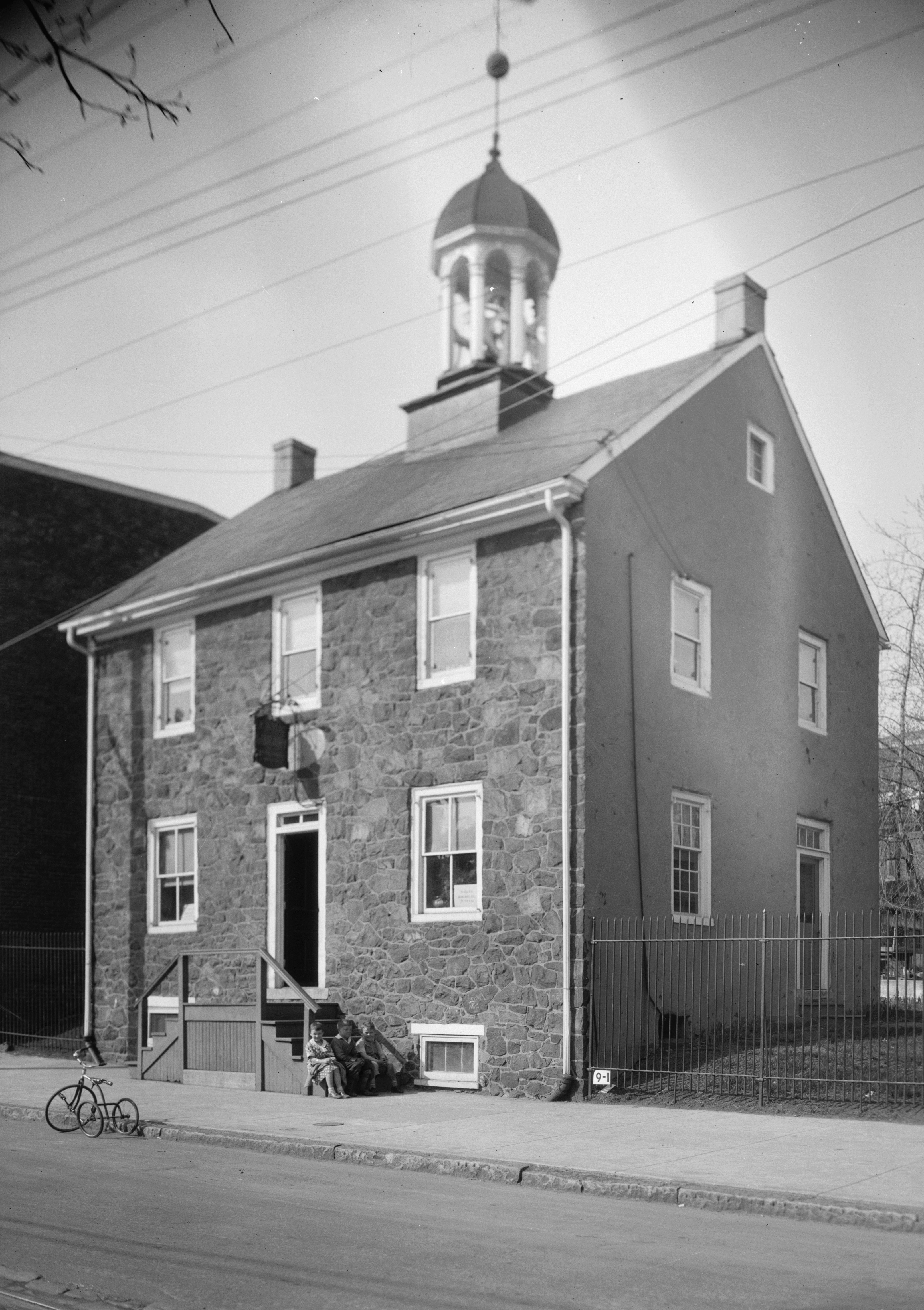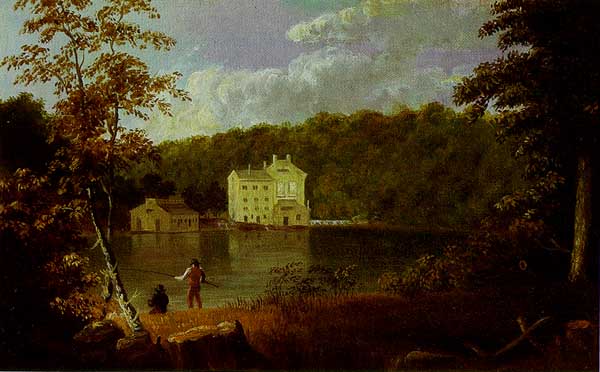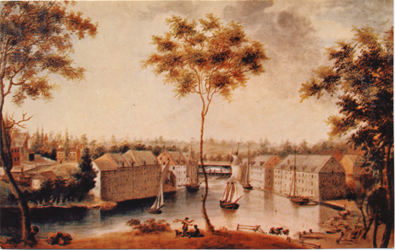Brandywine Village on:
[Wikipedia]
[Google]
[Amazon]
 Brandywine Village was an early center of U.S. industrialization located on the
Brandywine Village was an early center of U.S. industrialization located on the


 Prominent Quaker millers, including the Canbys, Leas, and Tatnalls, built their stone homes along Market Street, and built the Brandywine Academy building in 1798. A cupola was added to the academy in 1820, and it rang as the
Prominent Quaker millers, including the Canbys, Leas, and Tatnalls, built their stone homes along Market Street, and built the Brandywine Academy building in 1798. A cupola was added to the academy in 1820, and it rang as the
Hagley's Industrial Brandywine
{{coord, 39, 45, 8, N, 75, 32, 27, W, type:city_region:US-DE, display=title History of Delaware Neighborhoods in the United States Wilmington, Delaware
 Brandywine Village was an early center of U.S. industrialization located on the
Brandywine Village was an early center of U.S. industrialization located on the Brandywine River
Brandywine Creek (also called the Brandywine River) is a tributary of the Christina River in southeastern Pennsylvania and northern Delaware in the United States. The Lower Brandywine (the main stem) is longU.S. Geological Survey. National Hydr ...
in what is now Wilmington, Delaware
Wilmington ( Lenape: ''Paxahakink /'' ''Pakehakink)'' is the largest city in the U.S. state of Delaware. The city was built on the site of Fort Christina, the first Swedish settlement in North America. It lies at the confluence of the Christina ...
.
The Brandywine crosses the Fall Line
A fall line (or fall zone) is the area where an upland region and a coastal plain meet and is typically prominent where rivers cross it, with resulting rapids or waterfalls. The uplands are relatively hard crystalline basement rock, and the coa ...
just north of Wilmington, and descends from about above sea level in Chadds Ford to just a few feet above sea level in Wilmington. The river's descent allowed manufacturers — notably, of flour and gunpowder — to use high-powered machinery in the days before the steam engine
A steam engine is a heat engine that performs mechanical work using steam as its working fluid. The steam engine uses the force produced by steam pressure to push a piston back and forth inside a cylinder. This pushing force can be trans ...
, while its navigable channel to the Delaware River
The Delaware River is a major river in the Mid-Atlantic (United States), Mid-Atlantic region of the United States. From the meeting of its branches in Hancock (village), New York, Hancock, New York, the river flows for along the borders of N ...
and Delaware Bay
Delaware Bay is the estuary outlet of the Delaware River on the northeast seaboard of the United States. It is approximately in area, the bay's freshwater mixes for many miles with the saltwater of the Atlantic Ocean.
The bay is bordered inlan ...
allowed them to load oceangoing ships.
History
By 1687, a Swedish colonist, Tyman Stidham opened the first mill on the Brandywine, near Wilmington. About 1735, Brandywine Village was founded across the creek from Wilmington.Quaker
Quakers are people who belong to a historically Protestant Christian set of Christian denomination, denominations known formally as the Religious Society of Friends. Members of these movements ("theFriends") are generally united by a belie ...
s Elizabeth Levis Shipley, her husband William Shipley,
and Thomas Canby were important in establishing the village and its supporting flour mills. By 1743, Thomas's son Oliver owned 3 mill sites. A dam and a millrace south of the creek had been built.


 Prominent Quaker millers, including the Canbys, Leas, and Tatnalls, built their stone homes along Market Street, and built the Brandywine Academy building in 1798. A cupola was added to the academy in 1820, and it rang as the
Prominent Quaker millers, including the Canbys, Leas, and Tatnalls, built their stone homes along Market Street, and built the Brandywine Academy building in 1798. A cupola was added to the academy in 1820, and it rang as the Marquis de Lafayette
Marie-Joseph Paul Yves Roch Gilbert du Motier, Marquis de La Fayette (6 September 1757 – 20 May 1834), known in the United States as Lafayette (, ), was a French aristocrat, freemason and military officer who fought in the American Revoluti ...
visited on October 6, 1824. By 1806 there were "about fifty or sixty snug brick, stone, and frame houses" in the village and about 12 mills.
In 1760 a bridge was built at the current site of the Market Street Bridge, and the north race and two more flour mills were built by Joseph Tatnall Joseph Tatnall (1740–1813) was an American businessman, who was a prominent Quaker merchant, miller, and banker in Wilmington, Delaware.
Early life
The only son of Edward and Elizabeth (Pennock) Tatnall, Joseph was born in Wilmington on November ...
.
Oliver Evans
Oliver Evans (September 13, 1755 – April 15, 1819) was an American inventor, engineer and businessman born in rural Delaware and later rooted commercially in Philadelphia. He was one of the first Americans building steam engines and an advoca ...
in the 1780s helped local mills increase their efficiency, ushering in the industrial revolution
The Industrial Revolution was the transition to new manufacturing processes in Great Britain, continental Europe, and the United States, that occurred during the period from around 1760 to about 1820–1840. This transition included going f ...
. His first design for a fully integrated automatic flour mill was first used for a mill on nearby Red Clay Creek
Red Clay Creek is a tributary of White Clay Creek, running through southeastern Pennsylvania and northern Delaware in the United States. As of 2000, portions of the creek are under wildlife habitat protection.
Course
The East and West branche ...
in 1783 and gradually gained acceptance from Brandywine millers. The grain was unloaded on the ground floor and raised to the top floor by waterpower. Gravity moved the grain through the stages of cleaning, drying, grinding, spreading, and cooling, in a continuous manufacturing process.
The first paper mill
A paper mill is a factory devoted to making paper from vegetable fibres such as wood pulp, old rags, and other ingredients. Prior to the invention and adoption of the Fourdrinier machine and other types of paper machine that use an endless belt, ...
in Delaware was opened by Joshua Gilpin, Thomas Gilpin, Jr. and Miers Fisher in 1787 in Brandywine Village. This site was later used by one of the largest textile mill
Textile Manufacturing or Textile Engineering is a major industry. It is largely based on the conversion of fibre into yarn, then yarn into fabric. These are then dyed or printed, fabricated into cloth which is then converted into useful goods ...
s in the world, Bancroft Mills
Bancroft Mills is an abandoned mill complex along Brandywine Creek in Wilmington, Delaware, United States. It has been the site of some of the earliest and most famous mills near Wilmington and was the largest and longest running complex along ...
, which is now closed.
In 1795 Jacob Broom
Jacob Broom (October 17, 1752 – April 25, 1810) was an American Founding Father, businessman, and politician from Wilmington, Delaware. As a delegate to the U.S. Constitutional Convention of 1787, he was a signer of the United States Constituti ...
built the first cotton mill on the Brandywine, a few miles north of the village.
The mill burned down in 1797, and in 1802 Broom sold the site, complete with a working dam
A dam is a barrier that stops or restricts the flow of surface water or underground streams. Reservoirs created by dams not only suppress floods but also provide water for activities such as irrigation, human consumption, industrial use ...
and millrace
A mill race, millrace or millrun, mill lade (Scotland) or mill leat (Southwest England) is the current of water that turns a water wheel, or the channel (sluice) conducting water to or from a water wheel. Compared with the broad waters of a mi ...
, to Eleuthère Irénée du Pont, who paid $6,740 for the .Kinnane, Adrian (2002). ''DuPont: From the Banks of the Brandywine to Miracles of Science''. Wilmington: E.I. du Pont de Nemours and Company. Gunpowder mills, known as the Eleutherian Mills
From 1802 to 1921, Eleutherian Mills was a gunpowder mill site used for the manufacture of explosives founded by Eleuthère Irénée du Pont, which grew into the DuPont company. The name also refers to the house on the hill above the mills, whi ...
, operated on the site from 1802, and by 1810 the site was the largest gunpowder producer in the country. During the Civil War
A civil war or intrastate war is a war between organized groups within the same state (or country).
The aim of one side may be to take control of the country or a region, to achieve independence for a region, or to change government policies ...
alone, over 4 million barrels of gunpowder were produced here. The mills, which operated until 1921, are now part of the Hagley Museum and Library
The Hagley Museum and Library is a nonprofit educational institution in unincorporated New Castle County, Delaware, near Wilmington. Covering more than along the banks of the Brandywine Creek, the museum and grounds include the first du Pont ...
.
In 1796 the village contained 12 mills that could grind 400,000 bushels of grain per year. By 1815 several toll roads connected the village with Pennsylvania's grain-growing regions, including the Lancaster, Kennett and Concord Pikes. These roads later became Delaware Route 41
Delaware Route 41 (DE 41) is a highway in northwestern New Castle County, Delaware. Its southern terminus is at DE 2 and DE 62 in Prices Corner. From DE 2, the road passes through suburban areas along Newport Gap Pike, ...
, Delaware Route 52
Delaware Route 52 (DE 52) is a state highway in New Castle County, Delaware. The route runs from U.S. Route 13 Business (US 13 Bus.) in downtown Wilmington north to Pennsylvania Route 52 (PA 52) at the Pennsylvan ...
, and parts of US 202
U.S. Route 202 (US 202) is a spur route of US 2. It follows a northeasterly and southwesterly direction stretching from Delaware to Maine, also traveling through the states of Pennsylvania, New Jersey, New York, Connecticut, Mass ...
combined with Delaware Route 202
Delaware Route 202 (DE 202), also known as Concord Avenue, is a short state highway mostly within Wilmington, Delaware. It runs from U.S. Route 13 Business (US 13 Bus., North Market Street) north to a modified cloverleaf in ...
.
The millers cooperated in maintaining quality and branding the flour. "Brandywine Superfine" flour was shipped all along the Atlantic coast and to the West Indies
The West Indies is a subregion of North America, surrounded by the North Atlantic Ocean and the Caribbean Sea that includes 13 independent island countries and 18 dependencies and other territories in three major archipelagos: the Greater A ...
before the American Revolution.
The village was annexed by the City of Wilmington in 1869. It is now a historic district in the city.
A mill race
A mill race, millrace or millrun, mill lade (Scotland) or mill leat (Southwest England) is the current of water that turns a water wheel, or the channel ( sluice) conducting water to or from a water wheel. Compared with the broad waters of a mi ...
once used to provide water power is still in working condition in Brandywine Park near downtown Wilmington. This park was designed in the 1890s by Frederick Law Olmsted
Frederick Law Olmsted (April 26, 1822August 28, 1903) was an American landscape architect, journalist, social critic, and public administrator. He is considered to be the father of landscape architecture in the USA. Olmsted was famous for co- ...
.
Notes
External links
Hagley's Industrial Brandywine
{{coord, 39, 45, 8, N, 75, 32, 27, W, type:city_region:US-DE, display=title History of Delaware Neighborhoods in the United States Wilmington, Delaware